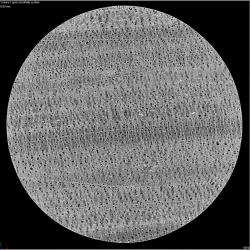Lamination

Lamination is the technique of manufacturing a material in multiple layers, so that the composite material achieves improved strength, stability, sound insulation, appearance or other properties from the use of differing materials. A laminate is a permanently assembled object by heat, pressure, welding, or adhesives.[1]
Materials
There are different lamination processes, depending on the type of materials to be laminated. The materials used in laminates can be the same or different, depending on the processes and the object to be laminated. An example of the type of laminate using different materials would be the application of a layer of plastic film—the "laminate"—on either side of a sheet of glass—the laminated subject.
Vehicle windshields are commonly made by laminating a tough plastic film between two layers of glass. This is to prevent shards of glass detaching from the windshield in case it breaks. Plywood is a common example of a laminate using the same material in each layer. Glued and laminated dimensioned timber is used in the construction industry to make wooden beams, Glulam, with sizes larger and stronger than can be obtained from single pieces of wood. Another reason to laminate wooden strips into beams is quality control, as with this method each and every strip can be inspected before it becomes part of a highly stressed component.
Building materials
Examples of laminate materials include melamine adhesive countertop surfacing and plywood. Decorative laminates are produced with decorative papers with a layer of overlay on top of the decorative paper, set before pressing them with thermoprocessing into high-pressure decorative laminates.[2] A new type of HPDL is produced using real wood veneer or multilaminar veneer as top surface. High-pressure laminates consists of laminates "molded and cured at pressures not lower than 1,000 lb per sq in.(70 kg per sq cm) and more commonly in the range of 1,200 to 2,000 lb per sq in. (84 to 140 kg per sq cm).[3] Meanwhile, low pressure laminate is defined as "a plastic laminate molded and cured at pressures in general of 400 pounds per square inch (approximately 27 atmospheres or 2.8 × 106 pascals).[4]
Paper
Corrugated fiberboard boxes are examples of laminated structures, where an inner core provides rigidity and strength, and the outer layers provide a smooth surface.
Laminating paper products, such as photographs, can prevent them from becoming creased, faded, water damaged, wrinkled, stained, smudged, abraded, or marked by grease or fingerprints. Photo identification cards and credit cards are almost always laminated with plastic film. Boxes and other containers are also laminated using a UV coating. Lamination is also used in sculpture using wood or resin. An example of an artist who used lamination in his work is the American Floyd Shaman.
Further, laminates can be used to add properties to a surface, usually printed paper, that would not have them otherwise. Sheets of vinyl impregnated with ferro-magnetic material can allow portable printed images to bond to magnets, such as for a custom bulletin board or a visual presentation. Specially surfaced plastic sheets can be laminated over a printed image to allow them to be safely written upon, such as with dry erase markers or chalk. Multiple translucent printed images may be laminated in layers to achieve certain visual effects or to hold holographic images. Many printing businesses that do commercial lamination keep a variety of laminates on hand, as the process for bonding many types is generally similar when working with arbitrarily thin material.
Photo laminators
Three types of laminators are used most often in digital imaging:
Film types
Laminate film is generally categorized into these five categories:
- Standard thermal laminating films
- Low-temperature thermal laminating films
- Heat set (or heat-assisted) laminating films
- Pressure-sensitive films
- Liquid laminate
See also
- Lamination paper
- Laminated bow
- Cladding (metalworking)
- Composite laminates
- Carbon-fibre reinforced plastic
- Composite material
- Epoxy
- Glass-reinforced plastic
- Sandwich-structured composite
- Wood
- Delamination
- Void (composites)
References
- ↑ Carter, Richard. "Method of laminating multiple layers". Google Patents. Retrieved 15 February 2015.
- ↑ "What Is Post-Formed Plastic Laminate?". Delorie Countertops and Doors. Retrieved 15 February 2015.
- ↑ McGraw-Hill Dictionary of Architecture & Construction
- ↑ McGraw-Hill Dictionary of Scientific & Technical Terms, 6E, Copyright © 2003 by The McGraw-Hill Companies, Inc.
